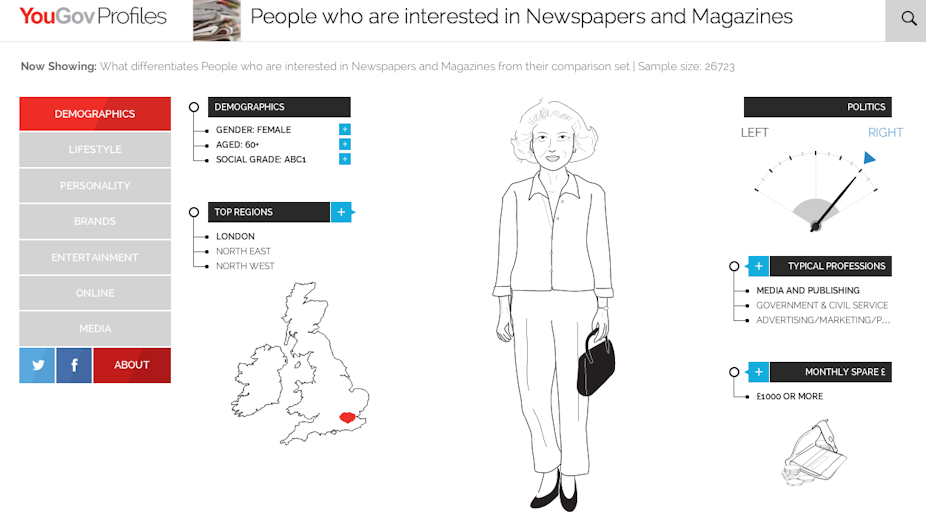One of the UK’s largest market research firms has caused a stir with an online tool that gives a peek into its treasure trove of consumer profiles. YouGov describes its Profiler app as “a showcase for some of the more fun, consumer-friendly data on the full version of YouGov profiles”. The full product is a new service aimed at helping businesses understand who their customers are and what they like – a practice known as “segmentation” in the business of marketing.
The app shows you the “quintessential profile” of people associated with any “brand, person or thing”. For example, according to the app, people who donate to the RSPCA are more likely to be right wing, female and working in healthcare. People who like Spam (the tinned meat product, not the electronic kind) are epitomised by men from Yorkshire who describe their personality as “occasionally grumpy”.
No juicy details
Media coverage of the app has been predictably self-referential, with many newspapers running stories on what it revealed about their readership. Some have mistakenly reported the profiles as representing the “average” or “typical” consumer of a brand. Actually, instead of showing a demographic breakdown, the Profiler app picks out what is “proportionally unique” about each group.
If consumers who like a certain brand are more likely than the general population to exhibit a certain trait, the app will create a profile with that trait. So, for a football team with a larger-than-average female fanbase compared to other teams, the tool might show a female character, even if the majority of the team’s fans are in fact male.
In other words, the tool doesn’t reveal the juicy details that professional marketers most want to know, but it does give a hint of what lies behind the full product. Perhaps the app is so appealing because, in claiming to show a product’s quintessential consumers, it confirms our commonly held stereotypes and exaggerates our perceived differences.
Cause for concern
While the use of consumer profiles has so far been relatively benign, it is easy to imagine the role they might play in a dystopian near future. Indeed, some market researchers are beginning to worry that consumers may find new forms of personalisation creepy, positing a hypothesis known as the “uncanny valley”. This says that consumers become disturbed if the personalised, targeted advertising gets too accurate.
Even if consumers were to overcome the uncanny valley of personalisation, and embrace its convenience, there may still be reasons for concern. One is the threat to individual autonomy from having decisions about you made automatically on the basis of a profile. Another is the possibility of discrimination.
Being a member of a disadvantaged group is likely to come with a variety of associations that could potentially be used in targeting. For instance, a well-tuned personalisation algorithm might not advertise books to a consumer group with statistically lower literacy rates. What might seem like helpful personalisation on the face of it, could turn out to undermine autonomy or pose a threat of discrimination.
For these reasons, the use of profiles is likely to come under increased scrutiny in years to come. To this end, the European Union’s proposed data protection reforms include a right to be informed about the existence and consequences of profiling. Another possible counter-measure is to give individuals control over their own profiles, and the ability to dictate who has access to what information in what context. Services offering users these kinds of technical controls have emerged in recent years.
Finally, as well as developing legal and technical instruments for individuals to control how they are profiled, there is also a wider debate to be had about the role of profiling in the digital age. In the mean time, we can continue to entertain ourselves (and stereotype each other) with the YouGov Profiler’s quintessential consumers.

